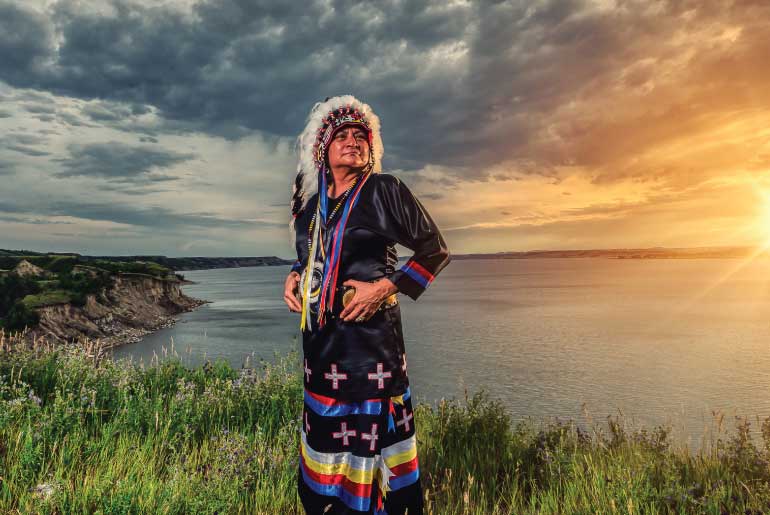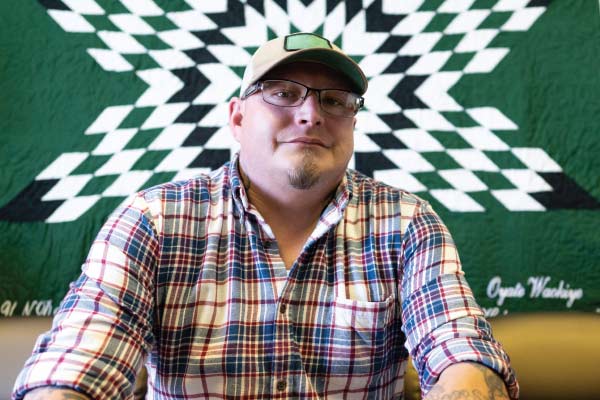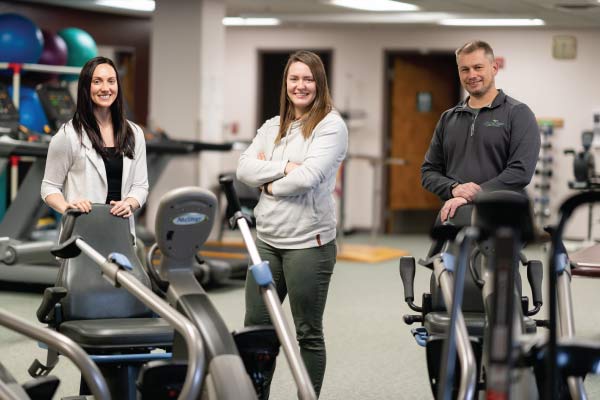Her Name Is Good Medicine
With the sight of a leader and the heart of a warrior, Dr. Monica Mayer, ’95, brings her healing touch home to serve her people.
As a child, Dr. Monica Mayer, ’95, often brought injured animals – cats with wounded legs or birds with broken wings – into her rural New Town, N.D., home. She nursed them back to health, healing fractured bones with popsicle sticks and tape and bottle-feeding abandoned nurslings.
She was given the name Good Medicine – “Xubaari Cagi” – by her grandmother according to custom of the Mandan, Hidatsa and Arikara Nation (also known as the Three Affiliated Tribes), becoming her great-grandmother’s namesake. Despite her caregiving nature, at the time a future career in medicine was not on her radar. She didn’t like school enough to obtain a medical education, and her grades were starting to show it.
Monica recalls a time as a high school freshman when her father, a farmer, set out to teach her and her sisters a lesson after a stretch of poor academic performance.
“My dad was a good man who took good care of his family,” she said. “He was a German fellow, you know, and Germans get up at the break of dawn and work all day, every day, till sunset.”
He drove them out to a farm field, about 15 miles from town, with nothing but a small sack lunch and a set of instructions: pick all of the rocks in the northwestern corner of the field – by hand – and put them into one pile – and only one pile. “When I come back, it better be done,” he said.
He returned around supper time to find his three daughters dirty, sore, and hungry. They were in tears, crying from a day of grueling labor. “He said, ‘Mama said you girls don’t like to go to school and you’re not getting good grades,’” Monica recounts. “‘So, we figured you might as well get used to how your life’s gonna be.’”
That was a turning point for Monica.
Armed with their father’s grit and their mother’s sage advice: “Love the Lord first, love your family second, and love to serve others third,” she went out into the world.
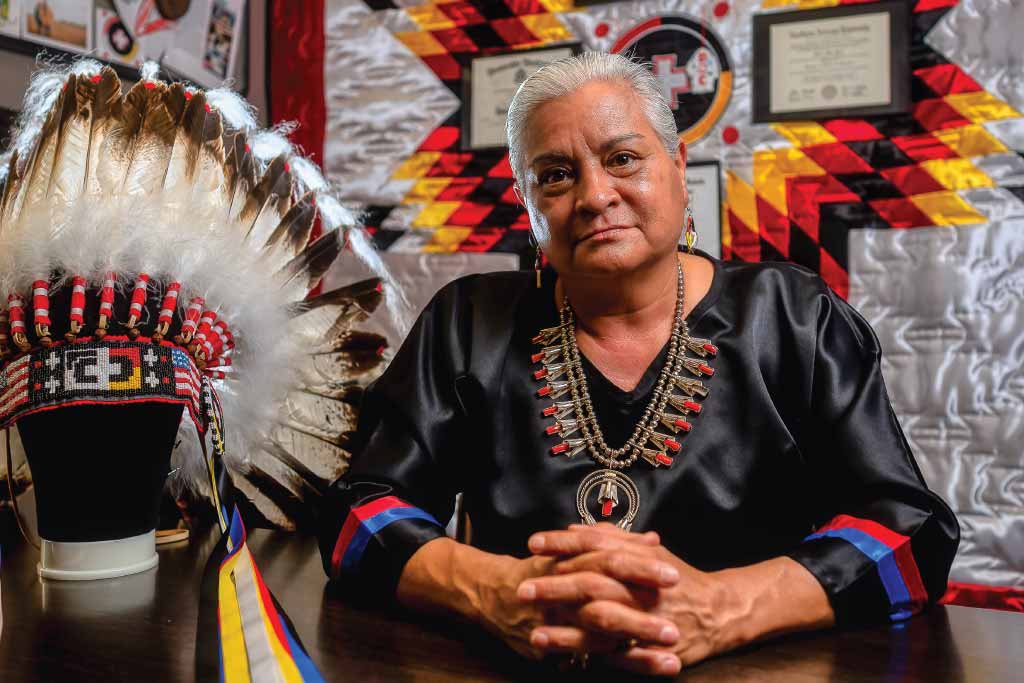
Dr. Monica Mayer, ’95, serves the Mandan Hidatsa and Arikara Nation Tribal Business Council, representing the North Segment of the Fort Berthold Indian Reservation. “I think I’ve given hope to young girls, and others, that they can run for office,” she said.
FORCED TO PIVOT
An all-state basketball player, Monica was fortunate to receive a scholarship to play ball at Williston State College (formerly the University of North Dakota-Williston). When her two-year associate’s degree was complete, she was more concerned with continuing her basketball career than her education. So, she headed south, joining the women’s basketball program at Northern Arizona University. Very quickly after arriving on campus, however, she suffered a career-ending knee injury.
“It changed my whole course of life,” Monica said. “Now, I had to really start using my brain.”
She completed a bachelor’s degree in science education and taught for a short time before feeling pulled toward a career in medicine. In her eyes, however, there was no easy path. “I always made excuses: 1. We don’t have any money; 2. I’m not smart enough; 3. I’m a girl – and girls didn’t go into medicine in those days; and 4. I’m Indian,” she said. “I had four strikes against me.”
Monica, however, wasn’t raised to make excuses, and she wasn’t raised to take the easy path.
So, she joined the Army.
A CALL TO SERVICE
Like many who sign up for the military, Monica considered it a high honor.
“Indian Country really honors veterans and people who pay service. They’re thought of very highly as warriors, you know, protecting the rights of the people,” she said. “I come from a family that has done a lot of service.”
Additionally, she sought tuition assistance for medical school and she wanted to gain some experience that would help her get accepted.
After serving six years (1984-90) in the U.S. Army Reserves as a medic and medical supply specialist for the 477th Medical Corps Company in Grand Forks, she was accepted into the UND School of Medicine & Health Sciences (SMHS) and attended on a scholarship through Indian Health Service (IHS).
“I was very grateful to the IHS scholarship and I remember telling (longtime associate dean of SMHS) Judy DeMers that I was going to serve in Indian Country,” Monica said. After completing her residency, she returned to New Town, on the Fort Berthold Indian Reservation, as a provider of family medicine.
I never practiced medicine to make patients dependent upon me. I try very hard to empower them with information on how to take care of themselves.
CLIMBING THE LADDER
Monica’s experience, helpful nature, and affinity for following procedure quickly moved her up the ranks into clinical administration. Before long, she was chief medical officer at the Belcourt, N.D., hospital, and soon was promoted to chief medical officer for the IHS’s Great Plains Area office, serving 19 medical facilities in four states.
During that time, she faced down public health crises that plague Native American communities, particularly diabetes, heart disease, and – perhaps most troubling to Monica – addiction. According to the CDC, the rate of overdose deaths among Native Americans increased 519% from 1999 to 2015 — more than any other group — and it remains well above the national average.
As she witnessed loved ones become devastated by the opioid epidemic, her mother’s words, “love to serve others,” rang in her ears. She made the difficult decision to leave her hard-earned and high-ranking post at IHS in exchange for making a direct impact back home.
Leaning on her education and experience practicing medicine, she ran for Tribal Business Council, the governing body of the Three Affiliated Tribes. She would represent the North Segment of the Fort Berthold Indian Reservation, where New Town – the reservation’s largest community – is located.
“My mother – my best friend and mentor – said ‘it’ll be just like medicine, only you’re taking care of people in a different way,’” Monica said.
She won by a landslide, becoming the first and only female physician to serve a tribal council in all 573 federally recognized tribes in the United States.
REBUILDING
When Monica returned to New Town at the beginning of her four-year term in 2016, she drove streets patrolled by packs of dogs and lined with trash, neighborhoods baring condemned buildings and broken-down vehicles. Visible signs of drug use dotted the scenery. “There were needles laying in the alleyways, tin foil in ditches,” she remembers.
She got to work, forming teams focused on housing and maintenance, and increased law enforcement from three staff members to 17. She breathed new life into Main Street, opening a laundromat, carwash, quick lube, and a wrecking yard. Up next: A daycare center.
“They’re not big moneymakers, but these are good services for our community,” Monica said.
She’s hired a staff more than 80 strong, and insists that they all become trained in CPR, Narcan administration, ethics, and more. She encourages them to run for community, tribal, and school board leadership positions.
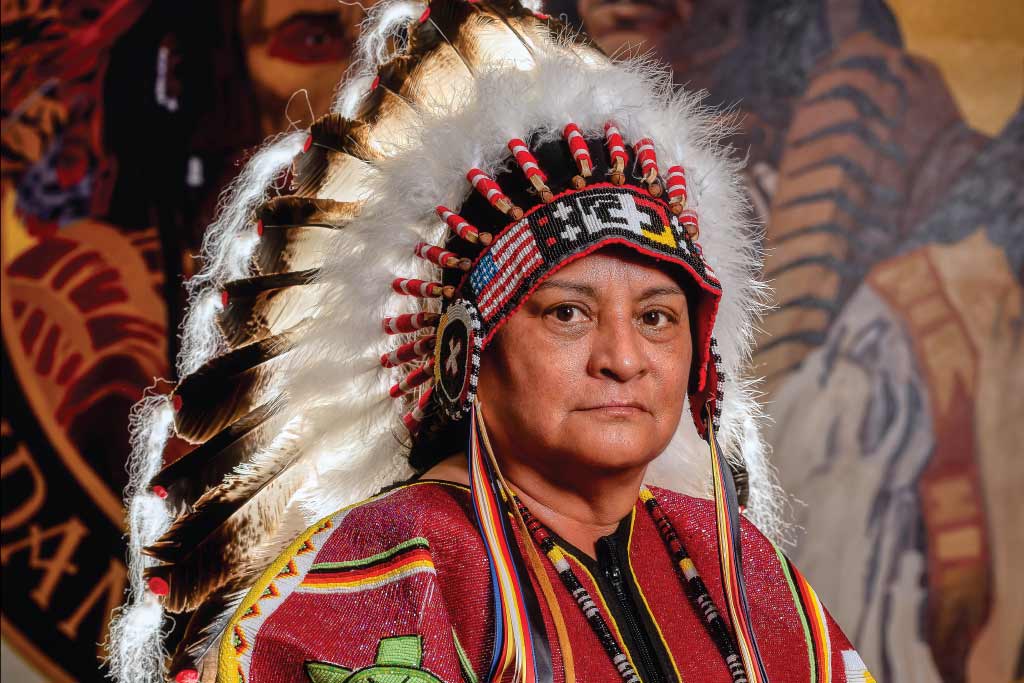
Dr. Monica Mayer is an enrolled member of the Mandan, Hidatsa, and Arikara Nation. As someone who has earned a great place of honor among her tribe — a veteran, an elder, and a tribal councilperson — she adorns a traditional Native American war bonnet for ceremonial purposes. The headdress is made of genuine eagle feathers, a mark of high respect, and it is worn while leading out in powwows and other events.
FIGHTING FOR YOUTH
In 2016, the New Town school had a 52% graduation rate. Attendance hovered around 55%. Just four years later, with Monica teaming up with the district superintendent, the graduation rate was closer to 90%, and the Class of 2020 graduated the most Honor Students in decades.
Monica has made it her mission to see that youth have the tools and motivation to achieve academically: every child receives a backpack filled with school supplies and the top 10 grade-earners in each class are rewarded with a bicycle.
“I always tell the kids that an education is the only guarantee in life and the one thing that absolutely no one can take from you. And you make a living off it and take care of your family,” she said. “I figure that if I keep pushing academics, getting educated, and working hard during my time in office, it’ll have its payback somewhere down the line.”
FIGHTING FOR ELDERS
The age of COVID-19 brings new challenges in caring for an aging population, and the pandemic has hit tribal communities nationwide especially hard. The second Monica heard the word “pandemic,” her medical instincts kicked in. The North Segment – which houses about 300 elders (60 and older) quickly instituted a curfew, halted travel, limited gatherings to less than five people, and strongly encouraged the use of masks.
Monica’s staff made sure elders’ homes in their segment were safe, properly equipped, and accessible. They have consistently hand-delivered care packages to all elders, stocked with Clorox wipes, Kleenex, toilet paper, hand sanitizer, medications, and grocery store gift cards. Monica provided thermometers, pulse oximeters and blood pressure cuffs, along with instructions on how to use them.
“As a doctor, I never practiced medicine to make patients dependent upon me,” she says. “I try very hard to empower them with information on how to take care of themselves.”
Still, Monica says that the coronavirus, though very serious, isn’t the most pressing health crisis in her segment.
“So far (in late June), we’ve got no deaths from COVID,” Monica says. “But we have multiple deaths weekly from drug activity and overdoses.”
A WORLD STAGE
“Doc M,” as she’s affectionately known to the people in her community, continues to do what she can to provide health education and combat addiction, diabetes, and other public health concerns.
Shortly after being elected to Tribal Council, she read a report from the National Institutes of Health in which data revealed the high rates of abuse among Indigenous women.
“Native American women are raped, assaulted, molested, and murdered 10 times more than any other race of women in the United States,” Monica said. “That piece of data was astounding to me.”
Monica was introduced to Victoria Tauli-Corpuz, the United Nations’ special rapporteur for Indigenous Peoples when Tauli-Corpuz visited the U.S. to further investigate the epidemic of violence against American Indian women. Sharing a mutual passion for the protection of women and families, she invited Monica to testify before the U.N. in Geneva, Switzerland, on the need for continued vigilance in fighting human trafficking specific to tribal communities.
Adorned in her traditional Native American headdress, or war bonnet, with genuine eagle feathers, the Human Rights Council couldn’t help but take notice of Monica. “You only get three minutes, so everyone else gets up to read so fast that you can’t understand them. But I spoke very loud and very clear and very slow. And I got everybody’s attention.”
She’s still got everybody’s attention. She heals, leads, serves, and fights for her people, and her name is Good Medicine.

